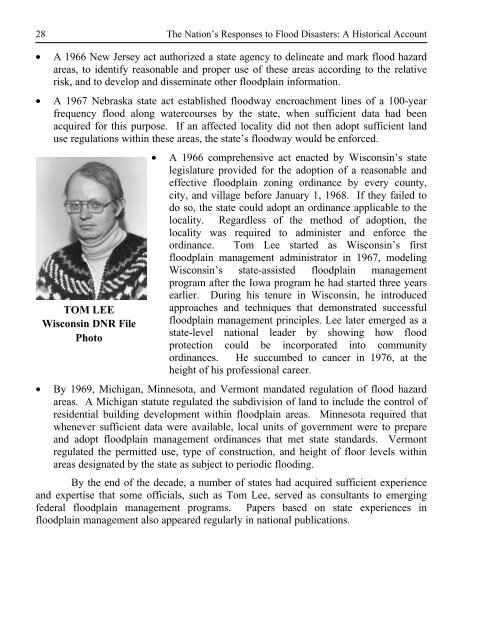The Nation's Responses To Flood Disasters: A Historical Account
The Nation's Responses To Flood Disasters: A Historical Account
The Nation's Responses To Flood Disasters: A Historical Account
Create successful ePaper yourself
Turn your PDF publications into a flip-book with our unique Google optimized e-Paper software.
28<br />
TOM LEE<br />
Wisconsin DNR File<br />
Photo<br />
<strong>The</strong> Nation’s <strong>Responses</strong> to <strong>Flood</strong> <strong>Disasters</strong>: A <strong>Historical</strong> <strong>Account</strong><br />
• A 1966 New Jersey act authorized a state agency to delineate and mark flood hazard<br />
areas, to identify reasonable and proper use of these areas according to the relative<br />
risk, and to develop and disseminate other floodplain information.<br />
• A 1967 Nebraska state act established floodway encroachment lines of a 100-year<br />
frequency flood along watercourses by the state, when sufficient data had been<br />
acquired for this purpose. If an affected locality did not then adopt sufficient land<br />
use regulations within these areas, the state’s floodway would be enforced.<br />
• A 1966 comprehensive act enacted by Wisconsin’s state<br />
legislature provided for the adoption of a reasonable and<br />
effective floodplain zoning ordinance by every county,<br />
city, and village before January 1, 1968. If they failed to<br />
do so, the state could adopt an ordinance applicable to the<br />
locality. Regardless of the method of adoption, the<br />
locality was required to administer and enforce the<br />
ordinance. <strong>To</strong>m Lee started as Wisconsin’s first<br />
floodplain management administrator in 1967, modeling<br />
Wisconsin’s state-assisted floodplain management<br />
program after the Iowa program he had started three years<br />
earlier. During his tenure in Wisconsin, he introduced<br />
approaches and techniques that demonstrated successful<br />
floodplain management principles. Lee later emerged as a<br />
state-level national leader by showing how flood<br />
protection could be incorporated into community<br />
ordinances. He succumbed to cancer in 1976, at the<br />
height of his professional career.<br />
• By 1969, Michigan, Minnesota, and Vermont mandated regulation of flood hazard<br />
areas. A Michigan statute regulated the subdivision of land to include the control of<br />
residential building development within floodplain areas. Minnesota required that<br />
whenever sufficient data were available, local units of government were to prepare<br />
and adopt floodplain management ordinances that met state standards. Vermont<br />
regulated the permitted use, type of construction, and height of floor levels within<br />
areas designated by the state as subject to periodic flooding.<br />
By the end of the decade, a number of states had acquired sufficient experience<br />
and expertise that some officials, such as <strong>To</strong>m Lee, served as consultants to emerging<br />
federal floodplain management programs. Papers based on state experiences in<br />
floodplain management also appeared regularly in national publications.
















